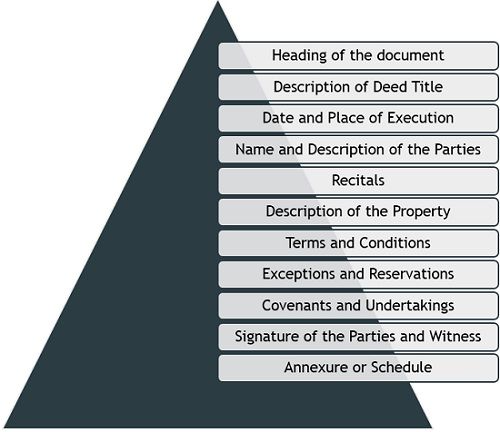Definition: A deed is a formal and dignified instrument. In general, it refers to any document by which two or more parties agree to put into force any right or liability.
For instance: Gift Deed, Partnership Deed, Trust Deed, Deed of Family Settlement, Mortgage Deed, Lease Deed, Sale Deed, etc.
In law, a deed is described as a written instrument which claims or operates to create, affirm, confirm, assign, restrict or put an end to some right, title or interest. It is of a non-testamentary nature which is duly signed & sealed and delivered to the transferee by which an interest, right or property is transferred or a binding obligation is created on a person.
Components of Deed
A deed contains various paragraphs, wherein each paragraph is concerned with specific details or information in a comprehensive language. The key components of a deed are:
- Heading of Document: It should mention the title of the deed.
- Description of the deed title: The description of the deed title, which starts with the name of the deed and so the deed must contain the accurate title, i.e. “This Deed of Partnership” or “This Deed of Sale”. Further, these words have to be written in block letters.
- Date and place of execution: The execution date of the deed, follows the description of the deed title, which is relevant in a document, for the applicability of the law, maturity period, registration and transfer of title, etc.
- Name and Description of the parties: Name and details such as age, address, etc. of all the parties and inter-parties, concerned should be stated in the document. At the time of describing the parties, the details of the transferor are stated prior to the details of the transferee. And if there is any confirming party, his/her details are to be mentioned after the details of the transferor.
- Recitals: It includes the precise story of the property to the point, it is bestowed to the transferors. It must be kept in mind that the recital is simple and abridged.
- Description of Property: Full description of the property needs to be provided in the document, presented for registration, as per the Registration Act. A complete description of the property is also important because it makes it easier to identify the property in the records of the Government and check if it is free from any charge.
- Terms and Conditions: As the name suggests, terms and conditions specify the general and special arrangements, rules, requirements, specifications, etc.
- Exceptions and Reservations: It implies the introduction of specific rights to be held by the transferor over the property to be agreed by the transferee.
- Covenants and Undertakings: It alludes to the agreement under seal, by which the parties concerned, promises for the truth of the certain fact. It is written as “The Parties aforementioned hereto hereby mutually agree with each other as follows:”
- Signature of the Parties and Witness: After attestation, the signature of the parties and their witnesses need to follow.
- Annexure or Schedule: A deed is regarded as incomplete unless the particulars required by the registration law concerning the land or property are provided in the Schedule to be attached with the deed.
For the execution of a deed, a stamp paper of a prescribed value is required.
Kinds of Deed
There are several kinds of the deed, namely:
- Good Deed
- Good and Sufficient Deed
- Inclusive Deed
- Latent Deed
- Lawful Deed
- Pretended Deed
- Voluntary Deed
- Warranty Deed
- Special Warranty Deed
What is a Deed Pool?
When a deed is executed amidst two or more than two persons and multiple copies of the deed are created, such that each party possesses a copy of it. Such an arrangement is called a deed pool.

divya solan says
What is a latent deed and what is the purpose of it?